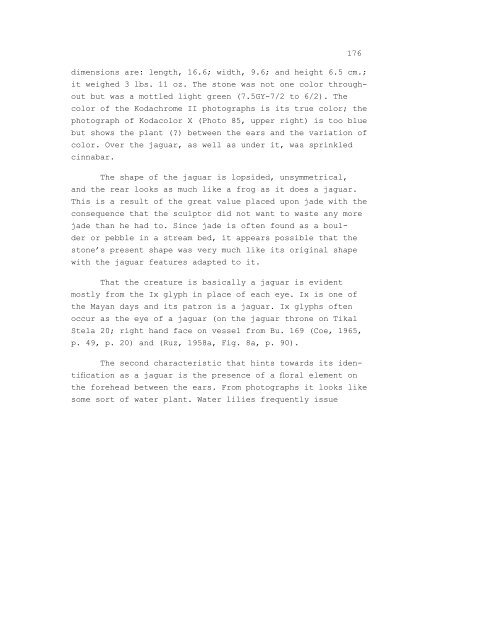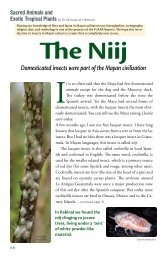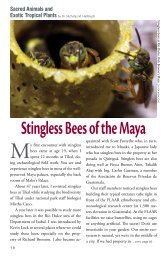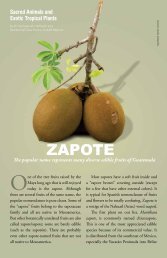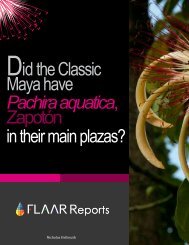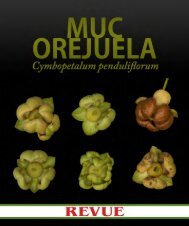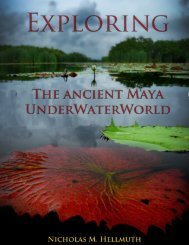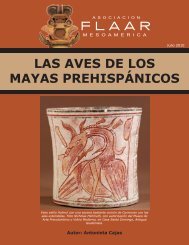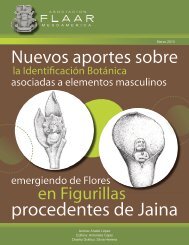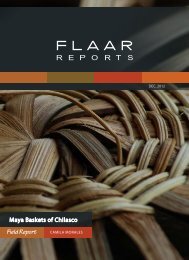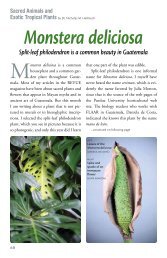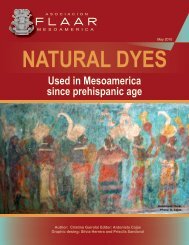Tikal Burial 196 Tomb of the Jade Jaguar - Maya Archaeology
Tikal Burial 196 Tomb of the Jade Jaguar - Maya Archaeology
Tikal Burial 196 Tomb of the Jade Jaguar - Maya Archaeology
You also want an ePaper? Increase the reach of your titles
YUMPU automatically turns print PDFs into web optimized ePapers that Google loves.
176<br />
dimensions are: length, 16.6; width, 9.6; and height 6.5 cm.;<br />
it weighed 3 lbs. 11 oz. The stone was not one color throughout<br />
but was a mottled light green (7.5GY-7/2 to 6/2). The<br />
color <strong>of</strong> <strong>the</strong> Kodachrome II photographs is its true color; <strong>the</strong><br />
photograph <strong>of</strong> Kodacolor X (Photo 85, upper right) is too blue<br />
but shows <strong>the</strong> plant (?) between <strong>the</strong> ears and <strong>the</strong> variation <strong>of</strong><br />
color. Over <strong>the</strong> jaguar, as well as under it, was sprinkled<br />
cinnabar.<br />
The shape <strong>of</strong> <strong>the</strong> jaguar is lopsided, unsymmetrical,<br />
and <strong>the</strong> rear looks as much like a frog as it does a jaguar.<br />
This is a result <strong>of</strong> <strong>the</strong> great value placed upon jade with <strong>the</strong><br />
consequence that <strong>the</strong> sculptor did not want to waste any more<br />
jade than he had to. Since jade is <strong>of</strong>ten found as a boulder<br />
or pebble in a stream bed, it appears possible that <strong>the</strong><br />
stone’s present shape was very much like its original shape<br />
with <strong>the</strong> jaguar features adapted to it.<br />
That <strong>the</strong> creature is basically a jaguar is evident<br />
mostly from <strong>the</strong> Ix glyph in place <strong>of</strong> each eye. Ix is one <strong>of</strong><br />
<strong>the</strong> <strong>Maya</strong>n days and its patron is a jaguar. Ix glyphs <strong>of</strong>ten<br />
occur as <strong>the</strong> eye <strong>of</strong> a jaguar (on <strong>the</strong> jaguar throne on <strong>Tikal</strong><br />
Stela 20; right hand face on vessel from Bu. 169 (Coe, <strong>196</strong>5,<br />
p. 49, p. 20) and (Ruz, 1958a, Fig. 8a, p. 90).<br />
The second characteristic that hints towards its identification<br />
as a jaguar is <strong>the</strong> presence <strong>of</strong> a floral element on<br />
<strong>the</strong> forehead between <strong>the</strong> ears. From photographs it looks like<br />
some sort <strong>of</strong> water plant. Water lilies frequently issue


